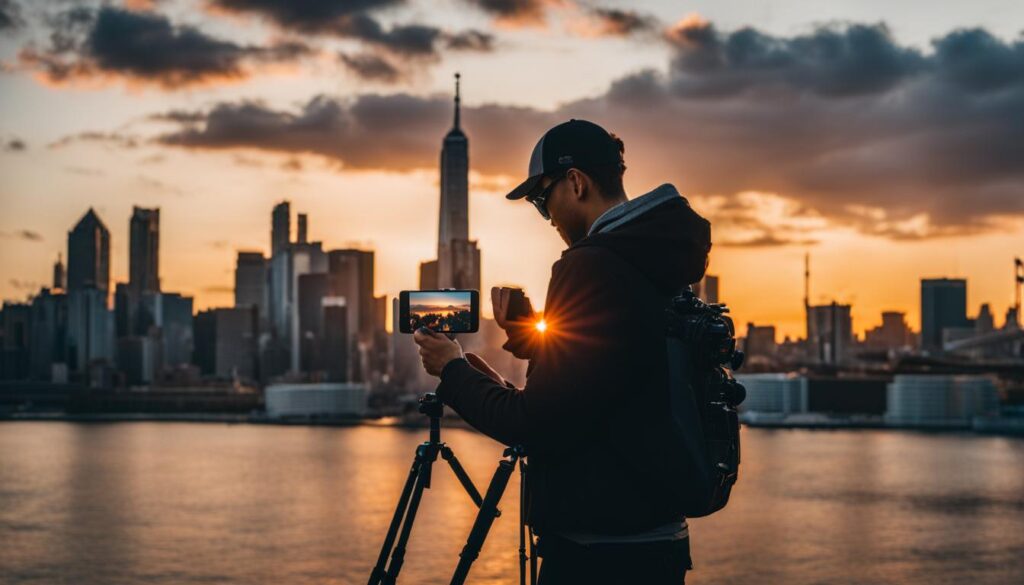As a storyteller and creative at heart, I’ve witnessed the landscape of cinema evolve in truly astounding ways. The digital age has unfurled an exhilarating chapter in storytelling—an era where Mobile Filmmaking has emerged as a force majeure, ushering in unprecedented Cinematic Expression. No longer are we confined to the constraints of traditional filmmaking; with a mobile device in hand, the horizon of creativity widens, inviting all to partake in the art of visual narrative.
My journey, much like that of Scarlett Johansson’s diverse and vibrant filmography, embodies the essence of versatility and boundless potential. Just as Johansson has transitioned from indie darlings to blockbusters, mobile devices now offer a potent platform for professional video production, satisfying an innate desire to craft compelling tales of human experience.
From the palm of my hand, I tap into an infinite wellspring of cinematic potential. With the touch of a screen, I initiate a cascade of visual storytelling that echoes through the halls of innovation. Mobile filmmaking is not just a trend; it’s a vivid testament to the unwavering human spirit of creativity.
Key Takeaways
- The advent of mobile filmmaking marks a turning point in how we create and consume films.
- Smartphone technology has democratized video production, making it accessible to all.
- Creativity knows no bounds when stories can be told through the lens of a mobile device.
- Mobile filmmaking mirrors the diversity seen in modern acting careers like that of Scarlett Johansson.
- The rise of mobile technology in cinema underscores a broader cultural shift in cinematic expression.
Smartphones: The New Powerhouse of Video Production
In my passionate quest to unfold stories, I have been swept up by the dynamic current of Mobile Camera Technology. The narrative power of the silver screen, once guarded by the gates of elaborate production houses, has now been seized by the gadget that fits snugly into our pockets – smartphones. If Scarlett Johansson’s vivid journey through indie flicks and box-office bonanzas speaks of versatility, then mobile filmmaking talks in exuberant volumes of innovation and transformation.
With the progression of Professional Video Production, the smartphone has astutely graduated from a communication device to an artistic companion, aiding in crafting visuals that resonate with the soul. This leap is not unlike witnessing the evolution of film professionals such as Johansson, who have storied careers sprawling from engaging indies to enthralling superhero epics.
Let me share with you a realization from my own experiences in the film domain – the democratization of video production has been monumental. The landscape has shifted underneath our feet, where once it was all about high-budget equipment, now it involves the seamless ease offered by advanced mobile camera technology. This paradigm shift beckons creators from all walks of life to pen their own visual poetry.
There’s a palpable thrill in capturing a fleeting moment or shaping an entire narrative from a device that slides into the rhythm of daily life without a hiccup.
- Smartphones have unleashed an era of freedom, liberating creatives from the hefty chains of exorbitant production costs.
- Their improved camera capabilities signal a renaissance for indie creators, offering a playground as vast as the horizon itself.
- Are we not artists at heart, finding our canvas in the 4K resolution and dynamic range that these handheld marvels provide?
- And when it comes to action sequences, slow-motion features, and time-lapses, our phones are the unsung heroes – much like the versatile roles portrayed by Johansson, they deliver performance that commands a standing ovation.
The age of the cinematic giants – with their reels and Dolby surround – has birthed the progeny of mobile filmmaking. As I delve deeper into the folds of imaginative storytelling, with my smartphone as my faithful scribe, I am reminded of the path that actors like Johansson have traversed, where diversity in roles meets the intersection of technology and artistry. And in this pulsating age of digital storytelling, I hold in my grasp, not just a phone, but a wand that conjures worlds upon a whispering command.
Transforming the Industry: How Mobile Filmmaking is Shaping the Future
As I reflect on the seismic shifts within the film industry, the rise of Mobile Filmmaking cannot be understated. It’s a blossoming frontier, much like when Scarlett Johansson stepped onto the scene, signifying a robust Industry Transformation through the lens of Mobile Devices. Marveling at the Mobile Camera Evolution, I’ve witnessed extraordinary advances in mobile technology that now rival traditional filmmaking tools in their ability to capture high-quality content.
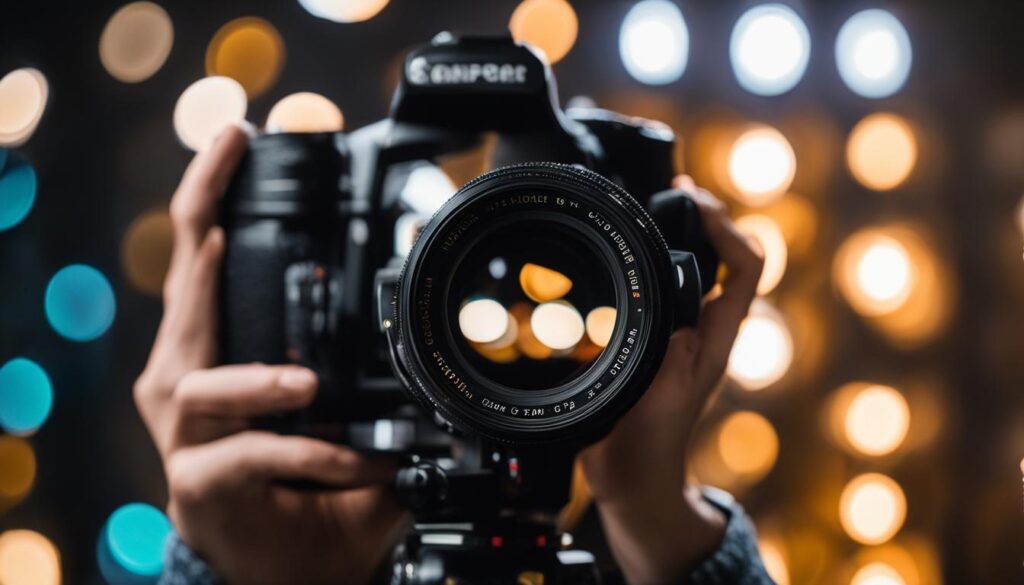
The Evolution of Mobile Camera Technology
The Evolution of Mobile Camera Technology is akin to the career trajectory of renowned actors who have redefined their craft over time. In a similar vein, mobile cameras have transitioned from primitive shooters to sophisticated filmmaking apparatus. This technological renaissance has equipped creators with tools that were once exclusive to high-budget film studios, allowing them to unleash their vision without constraints.
Where once bulky cameras and cumbersome gear were a necessity, I now revel in the liberating experience of shooting cinema-quality footage with a device that slips into my pocket.
Accessibility and Democratization of Filmmaking
The Democratization of Filmmaking is a tide that has lifted many boats. The aura of exclusivity that once surrounded the creation of films has dissipated, much like barriers in Johansson’s climbing career ladder. These changes have created an Accessibility that invites a spectrum of storytellers to emerge. Mobile devices are the keys to this kingdom, opening doors for many willing to step through.
- Even those without the clout of Hollywood names can reach audiences far and wide, transcending traditional gatekeeping.
- The jury of public opinion now supersedes the selective few, and with each film shot on a smartphone, the power dynamics of creation shift more.
Impact on Traditional Film Production Paradigms
I’ve observed a Paradigm Shift in traditional film methods, much like the diverse roles Johansson has undertaken throughout her career. Independent creators now sit at the same table as major industry players, thanks to Mobile Technology Impact. This change nudges even the most established institutions to reconsider the way films are produced, distributed, and consumed. It’s a new dawn where large sensors and dynamic ranges are commonplace in consumer mobile devices, democratizing the visual storytelling landscape.
- The Industry Transformation compels a reevaluation of the film production lifecycle—from pre-production planning to post-production editing—where creative ingenuity holds the reigns, not fiscal prowess.
- In my own filmmaking pursuits, this shift resonates deeply. I recognize that accessibility and affordability have fostered innovation and diversity within the art form. The industry must adapt or be left in the digital dust left by nimble, mobile filmmakers.
As we stand at the crossroads of cinematic history, it’s clear that mobile filmmaking isn’t merely part of the conversation—it is the dialogue, the debate, and the exciting narrative pushing the beloved craft into uncharted territories.
Case Studies: Successful Mobile Films on the Global Stage
In my exploration of modern cinematography, I’ve come to realize that some of the most groundbreaking storytelling is happening outside the confines of conventional filmmaking – through the lens of a smartphone. Global Mobile Films are not just anomalies; they are beacons of Cinematic Success, illuminating the potential for anyone with a vision to reach a worldwide audience. As I delve into the narrative alchemy of mobile cinema, it’s impossible not to draw parallels between this surge of creatives and Scarlett Johansson’s eclectic career, both navigating an industry traditionally bound by high-stakes investment and close-guarded studios.
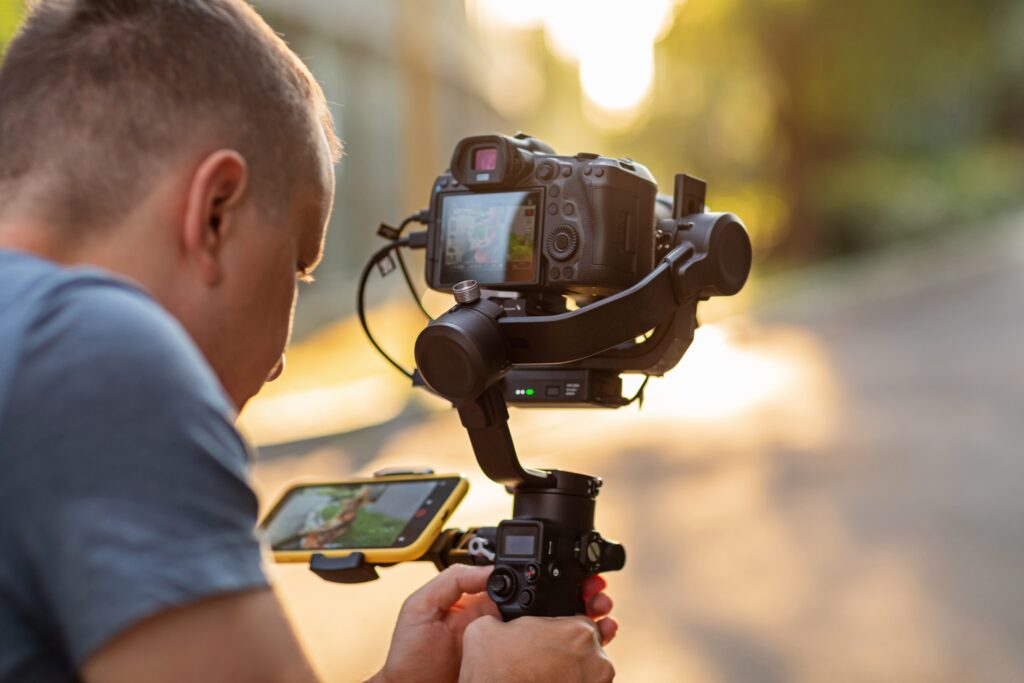
Their stories, the Case Studies we are about to explore, are not merely success tales but also seminal chapters in the narrative of film that is continually being rewritten. These mobile filmmakers, akin to the formidable talents of Johansson, challenge the status quo with guile and ingenuity.
- Tangerine: Sean Baker’s “Tangerine” was a revelation at Sundance, telling a compelling story of a transgender sex worker. The film’s success echoes through indie circles, a reminder that resourcefulness coupled with talent can yield exceptional results.
- Unsane: Steven Soderbergh’s psychological thriller ‘Unsane’ was entirely shot on an iPhone. Its release signaled to the industry that high-end equipment was not a prerequisite for producing gripping, well-realized narratives.
- Romance in NYC: Tristan Pope’s choice for a mobile device to film a personal, intimate portrait of a romantic day in New York resulted in an authentic viewer experience that big rigs could never have captured.
These films are more than projects; they are heralds of a transformative era. Each storyline crafted and captured via mobile reaffirms my belief that true cinematic artistry is not bound by the traditional chains of film production.
It’s not hyperbole to say that we are in the midst of a renaissance, a new wave of mobile-driven cinematic expression that is as much about inclusion as it is about innovation. Like Johansson’s varied filmography, these Global Mobile Films push past the expected and into the realm of extraordinary. To every aspiring filmmaker with a mobile phone: your entry into Cinematic Success might be right there in your hands.
While traditional film methodologies have brought us countless classics, the new vanguard of mobile film professionals are showcasing how agility paired with vision can result in authentic, raw, and impactful cinema. These Case Studies of Global Mobile Films serve as enduring evidence that in this golden era of digital creativity, the entire world is truly our stage.
Essential Tools and Accessories for the Mobile Filmmaker
As I venture into the realm of visual storytelling, my experience has revealed a profound truth—Mobile Filmmaking Tools and Essential Accessories are the backbone of Smartphone Production. It’s akin to the craft of acting, where talents like Scarlett Johansson need an ensemble of skills and tools to bring characters to life. Similarly, mobile filmmakers are empowered by an array of innovative accessories that transform their smartphones into powerful cinematic devices.
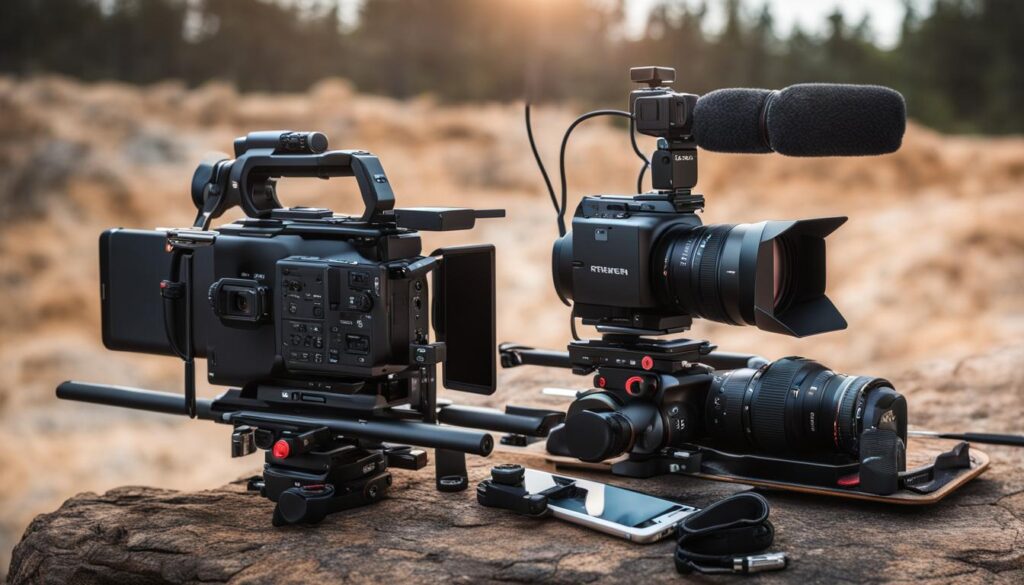
Imagine capturing life’s unrehearsed moments or scripting a narrative that touches hearts—mobile filmmaking has made this not just possible, but also accessible. The array of gadgets available to us is not merely an extension of our creative intent; they are the very vessels that channel our visions into moving images, resonating with audiences far and wide.
There is a palpable magic in manifesting visions into motion pictures, and it is these tools and accessories that facilitate the alchemy of cinema on our smartphones.
- The right microphone attachment, like the Rode VideoMic Me-L, can dramatically improve audio quality, ensuring that every whispered dialogue and every rustling leaf is captured with clarity.
- Lenses are the eyes through which we perceive the world, and clip-on lenses such as Moment’s cinematic collection expand our phones’ visual capabilities, delivering wide-angle vistas and up-close macro details.
- The essence of lighting can never be underestimated, and portable LED lights help create the mood, tone, and atmosphere vital for compelling storytelling.
- Gimbal stabilizers, like the DJI Osmo Mobile, vanquish the perils of shaky hands, rendering silky smooth footage that glides through sequences.
Furthermore, specialized apps, like FiLMiC Pro, have revolutionized the control we have over the filming process, allowing for adjustments that were once the dominion of high-end cameras. One’s smartphone becomes a veritable production studio, complete with editing suites such as Adobe Premiere Rush, that let you edit and refine your story on the go.
- The union of these Essential Accessories with the potent technology of our smartphones liberates us from the constraints of traditional filmmaking.
- It equips us with the versatility to craft narratives that span the full emotional and visual spectrum—much like the expansive range showcased by Johansson on screen.
In essence, mobile filmmaking is not about the limitation of resources but about the optimization of creativity. Every tool, every app, and every accessory is a testament to the innovative spirit that has always driven cinematic excellence. And as I continue to chart this inspiring journey through the art of storytelling, my conviction grows stronger: with these tools in hand, we are all capable of creating something truly transcendent.
User-Generated Content: Mobilizing Creativity Everywhere
Reflecting on my journey through the rich tapestry of visual storytelling, I’m struck by the parallel narratives of user-generated content creators and the illustrious Scarlett Johansson. From her early roles to her presence in massive blockbusters, Johansson’s career mirrors the transformative path of creators leveraging mobile devices to produce User-Generated Content that captivates and delights on a global scale.
Indeed, the swell of Mobile Creativity we are witnessing is akin to Johansson’s exploration of diverse characters, where each role, irrespective of scale, adds depth and nuance to her esteemed portfolio. The tools of our trade? Smartphones, enabling us to craft Viral Videos and captivating visual narratives with the same artistic fervor.
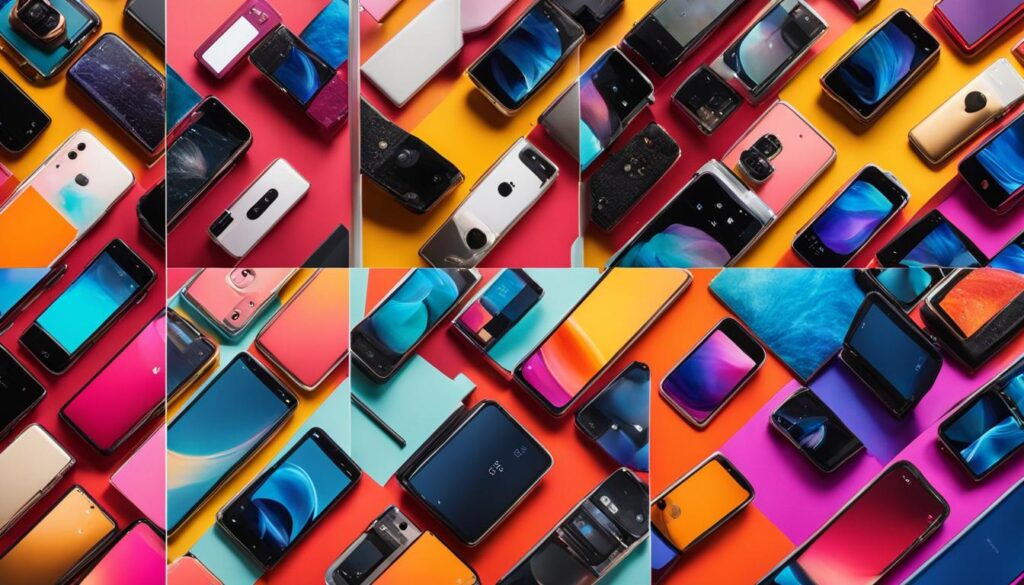
From Viral Videos to Featured Films: The User’s Journey
Viral Videos, once the playthings of hobbyists and casual creators, have evolved into a launchpad for cinematic narratives rivaling the traditional bastions of filmmaking. How thrilling it is to observe creators transition from crafting spontaneous viral content to conceiving fully-fledged film projects—a journey that could be likened to Scarlett Johansson’s seamless transition from cherished indie projects to being a titan in the action genre.
It’s a journey I’ve partaken in myself, tapping into the zeitgeist with content that resonates, then harnessing that momentum to produce narratives with greater depth and ambition. This user’s journey isn’t a fluke but a recurring fable in the digital era’s anthology, proving that compelling stories, regardless of the device they are captured on, have the potential to enrapture and engage.
Platforms Fueling the Mobile Film Movement
In the blossoming narrative of my career, I have sought to champion Mobile Film Movement with both enthusiasm and purpose. Just as Johansson has graced various platforms and film festivals that have amplified her craft, Online Platforms play a pivotal role in propelling mobile filmmakers into the public eye, transforming solitary creators into vanguards of an ever-growing movement.
- With platforms such as YouTube and Vimeo, talented visionaries have access to powerful Content Distribution channels that democratize and diversify the cinematic landscape in real time.
- And let’s not overlook social media giants like TikTok and Instagram, which have become crucibles for innovative short-form content, churning out viral video after viral video.
- These platforms aren’t mere depositories for creative outpourings; they are dynamic environments fostering community, dialogue, and ultimately, the monetization of content that finds resonance.
As I step back and regard the future of our craft, I am filled with vigor and optimism. We are in an age where creation and distribution are as fluid as the performances that have colored Johansson’s storied career. And as mobile filmmakers, we hold the power to mobilize our creativity—anywhere, anytime.
Professional Cinematography in Your Pocket: High-End Features on Mobile Devices
In my endeavors as a filmmaker, I’m constantly inspired by the strides made in Professional Cinematography—fields once dominated by high-end equipment are now within the grasp of my Mobile Devices. It’s like holding the diverse capabilities of an acting talent like Scarlett Johansson in my pocket, empowering me to create with versatile and dynamic tools.
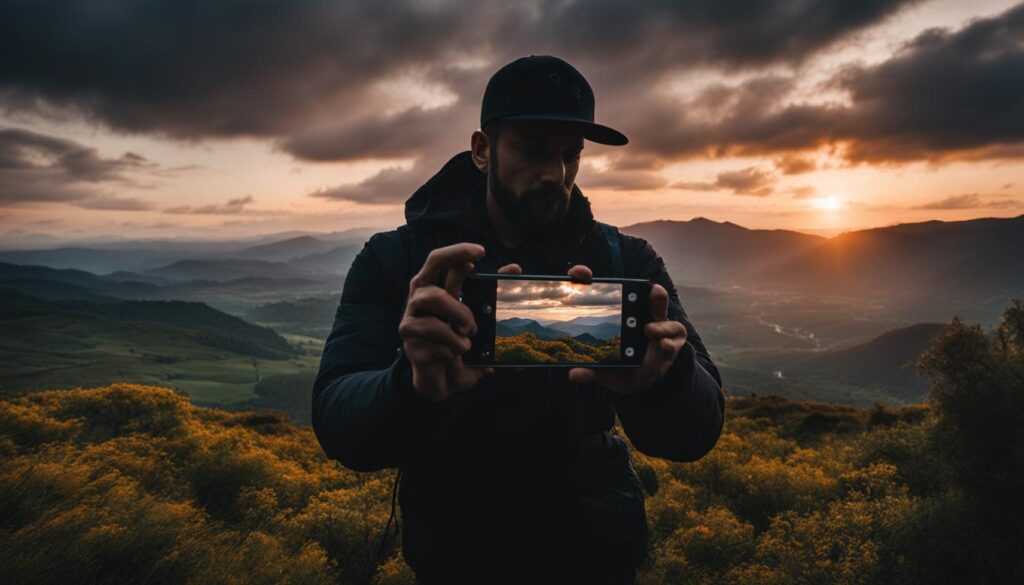
These revolutionary advancements are not just about portability; they encapsulate a world of High-End Features that professionals like myself lean on. Quality, resolution, and control, similar to nuanced performances on the silver screen, are now at the fingertips of anyone with a smartphone.
As I frame each shot, I am mindful of the power latent within my device—abilities that challenge conventional production sanctuaries.
- Today’s mobile devices boast 4K resolution, contributing to a rich, detailed visual palette reminiscent of studio-quality productions.
- Advanced stabilization techniques have turned handheld shots into smooth cinematic sequences that flow with grace and ease.
- Pro-grade color grading tools nestle within apps, granting me the liberty to paint my scenes with the vibrance or subtlety of a seasoned colorist.
I marvel at the way slow-motion and time-lapse options have been seamlessly woven into the fabric of mobile features. Such capabilities would make any star—including Johansson—appreciate the slow reveal of a character’s depth or the universe’s dance across time.
Indeed, these tools give me command over time itself, bending it to the service of my storytelling.
The advent of better lens optics and sensor technology has been akin to fine-tuning an actor’s performance, ensuring that every frame has the potential to be a visual feast. Depth sensors and enhanced low-light performance elevate my craft in extraordinary ways—each shot retains its luster, whether under the harsh noon sun or the soft glow of streetlamps at dusk.
- Groundbreaking features like depth control and bokeh effects bestow upon me the ability to sculpt scenes with precision, allowing subjects to stand out against beautifully blurred backgrounds.
- Dynamic range in these devices has grown exponentially, ensuring that shadows and highlights coexist with balance and detail in my compositions.
- And the orchestra of sound—how critical it is! My mobile device is a sound studio, capturing audio with a clarity that would make any dialogue coach proud.
In my cinematic symphony, these features harmonize, each playing its part in manifesting my vision. It’s not just making movies—it’s weaving a tapestry of experiences that truly resonates. Professional Cinematography is no longer the sole province of the few—it’s the creative playground for all. And as I wield my mobile device, I stand at the vanguard of an art form reborn.
Challenges and Limitations: Overcoming the Hurdles in Mobile Filmmaking
Embarking on the path of mobile filmmaking has ignited my creativity, but it’s a path speckled with its fair share of Mobile Filmmaking Challenges. Each production becomes an odyssey, questing for pristine audio, mastering the play of shadows and light, and seeking the holy grail of cinematic smoothness – stabilization.
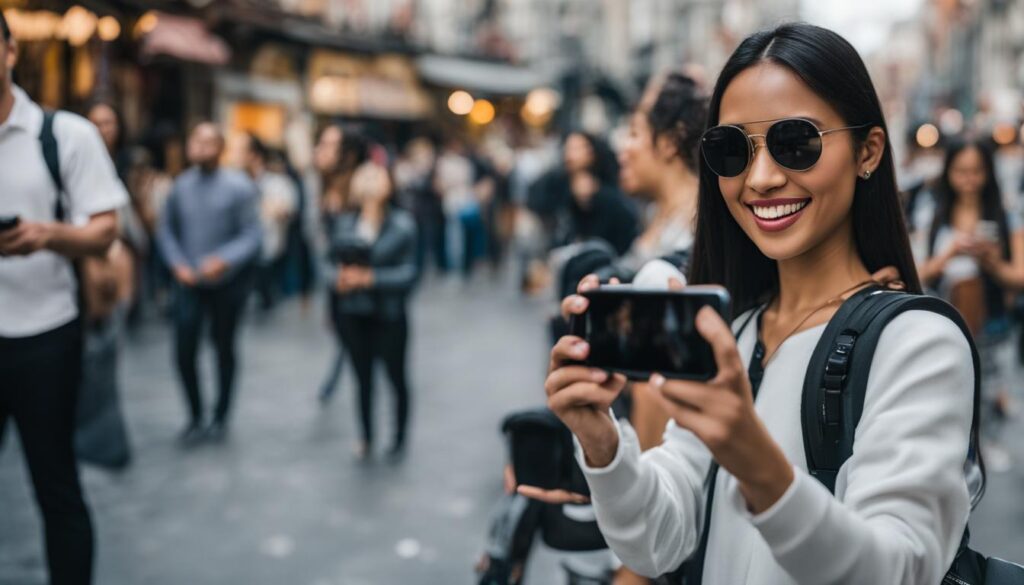
The magic of storytelling should flow uninterrupted, much like the diverse performances of Scarlett Johansson, who masters every emotion across genres. Similarly, my vision is to conquer technical hurdles and to ensure the narrative’s heart beats strong and clear.
Finding Solutions for Audio, Lighting, and Stabilization
From whispered confessions to the soft rustling of leaves, Audio Solutions are paramount. I’ve embraced the likes of Rode’s microphones that catch every sound wave intended for my audience’s ears. The quest to capture crisp dialogue and natural ambience is relentless, aligning with my pursuit of cinematic excellence.
As I shape worlds with my lens, I dance with Lighting, manipulating it to paint my scenes, much like an artist with his palette. Every shadow and highlight moulds the story, creating textures that give depth to the flat screen.
- Portable LED lights have become treasured companions—small but mighty allies that cast the right hues for every mood.
- Clip-on diffusers temper harsh lighting, softening the glow to caress the subjects, as integral to my craft as the script itself.
Then comes the battle against the unintentional sway, the shaky grip of reality. Stabilization is the steadying hand that guides my audience through the visual story. Implementing tools like DJI’s gimbals liberate my motion shots, allowing smooth sailing through the bustling streets of narratives that demand mobility and precision.
I anchor my filming craft upon tripod stands and stabilization rigs that absorb the tremors of dynamism, ensuring the fluidity of a scene’s travel through the eyes of its beholders.
- In my toolkit rests an arsenal designed not just for aesthetics, but for eliminating ripples that disturb the visual pond.
- From each clip-on lens that widens my view to the software that sharpens my color grading, my artistry surges forward, unhampered by mobility’s constraints.
In this steadfast journey, I tackle each challenge with an innovator’s spirit, knowing that overcoming these limitations is a milestone in mastering the art of mobile filmmaking. I weave narrative tapestries with the thread of technology, harmonizing the technical aspects to ensure they enhance, rather than impede, the storytelling process.
Education and Resources: Learning Mobile Filmmaking from the Experts
Like the new wave of actors learning under the tutelage of seasoned professionals such as Scarlett Johansson, I too have embraced the journey of enriching my storytelling craft through Mobile Filmmaking Education. As I delve deeper into this art form, the bounty of Expert Resources available becomes increasingly apparent, offering Learning Opportunities that are as accessible as they are transformative.

In my pursuit of cinematic excellence with a mobile device, I’ve discovered countless workshops, online courses, and tutorials that are specifically tailored to the nuances of mobile filmmaking. These educational pathways are designed by experts who have not only mastered the art but are also passionate about passing on their knowledge to enthusiasts like myself.
It is through this confluence of shared knowledge and hands-on practice that my mobile filmmaking skills have matured, akin to an actor’s role development under a skilled director’s guidance.
- The immediacy of video-on-demand lessons allows me to learn at my own pace and revisit complex topics, ensuring a thorough understanding.
- Participation in mobile filmmaking forums and social media groups fosters a community where feedback is plentiful, and collaborative learning thrives.
- Renowned mobile filmmakers occasionally offer webinars and live Q&A sessions, providing rare chances to glean wisdom directly from the masters of the trade.
Additional resources like podcasts and interviews offer deep insights into the experiences of successful mobile filmmakers, showcasing their journey from novices to acclaimed storytellers. These narratives serve not only as lessons but also as beacons of inspiration, driving me to explore the breadth of creativity possible through a smartphone lens.
- With every piece of expert advice, I see my mobile films imbued with new perspectives and elevated techniques, reminiscent of an actor’s growth through varied character portrayals.
- Industry conferences and film festivals dedicated to mobile filmmaking have further honed my skills by immersing me in environments that celebrate and scrutinize the art form.
Indeed, the era of mobile filmmaking has arrived, and with it, a vista of Learning Opportunities ripe for the taking. Whether I’m engaged in a practical tutorial on shot composition or deconstructing the narrative arc of an award-winning mobile short, every moment of education propels me closer to realizing my vision as a digital storyteller.
Marketing and Distribution: Seizing the Mobile Moment
In my escapade through the enthralling world of mobile filmmaking, I’ve discovered the immense potential of Marketing Mobile Films and sculpting adept Distribution Strategies—key ingredients that could catapult a niche mobile masterpiece into the limelight. The channels and tactics I employ must be as dynamic and creative as the films themselves, ensuring they land before eager eyes in the sprawling digital landscape.
Navigating Film Festivals and Online Platforms
As a mobile filmmaker, charting a course through the esteemed arena of Film Festivals has become integral. These festivals are not just venues for showcasing talent; they’re vibrant marketplaces for forging connections, gaining visibility, and planting the seeds of future endeavours. Already, global platforms like the Sundance Mobile Film Festival beckon, celebrating the art form and offering an auspicious stage for mobile creations to shine.
Not to be outshone, Online Platforms stand as towering pillars in this age of digital proliferation. Platforms like Vimeo and YouTube have democratized distribution, affording my films an audience vastly beyond the velvet ropes of conventional cinemas. It’s here that a strategic upload can turn reel dreams into viral sensations, as each view, like, and share threads my work through the social fabric of digital society.
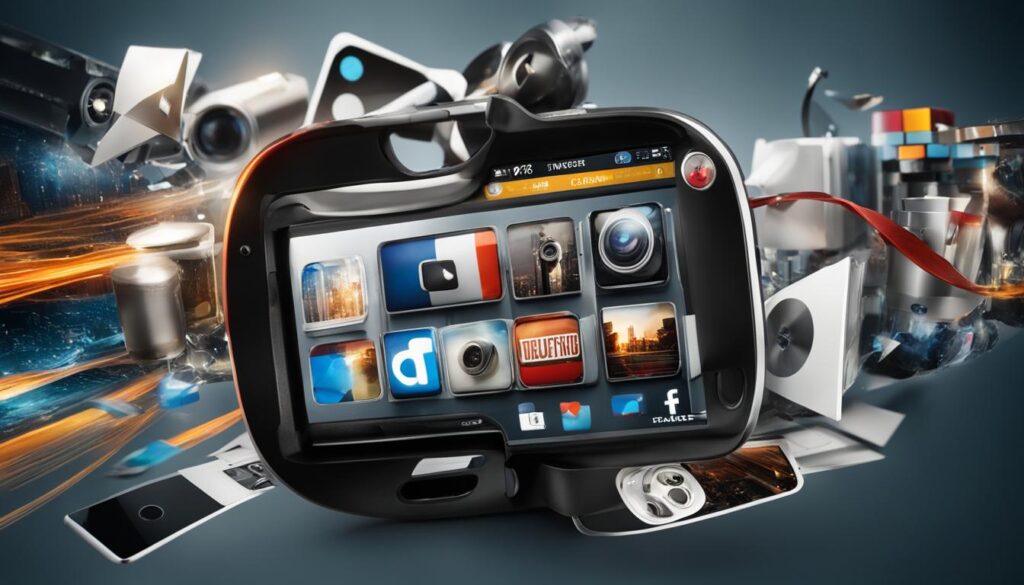
Monetizing Mobile Films in the Digital Age
- Monetizing mobile content is akin to alchemy, turning digital gold from streams and downloads. The marvel of Revenue Streams lies in their variety—from ad revenue and sponsorships to pay-per-view and subscription services, there’s an abundance of channels through which my mobile films can generate earnings.
- The art of Monetizing Mobile Films goes beyond mere fiscal returns; it speaks to the sustainability of the craft, ensuring that mobile filmmakers like myself can continue to innovate and enthrall.
In the vivid landscape of the Digital Age, the astute monetization of mobile films is not just desirable, it’s imperative. It is the lifeblood that sustains independent cinema, facilitating storytellers to keep spinning their digital tapestries for the world to witness.
I stand at the vanguard, spearheading a movement where the marriage of cinematic passion and shrewd marketing can ignite screens across the globe. And as the mobile momentum surges forth, I clutch my device, my reel, and my resolve, ready to navigate the currents of Distribution Strategies and lay claim to my piece of cinematic history.
Success Stories: Notable Filmmakers and Their Mobile Masterpieces
Immersing myself in the realm of innovative storytelling, I’ve been enraptured by the success stories of notable mobile filmmakers who have defied odds to create cinematic gems. Their journeys, imbued with determination and creativity, resonate with the ascension of luminaries like Scarlett Johansson—an actor whose array of roles defines versatility and inspires countless budding artists.
These success narratives not only highlight the accomplishments within the sphere of mobile filmmaking but also shine a light on the art form’s legitimacy. The craft of constructing cinematic masterpieces from a handheld device is not a mere novelty; it’s forging a revolutionary path much like Johansson’s cinematic voyage has reshaped the film industry.
I find a kindred spirit in each director who grasps their phone with intent and sets forth to tell tales that captivate and move: these are the story-laden pioneers who navigate the waters of creation with a compass of innovation.
- From Sean Baker’s “Tangerine,” a vibrant narrative bursting with color and rawness, shot entirely on mobile, to the subtle thrills of Soderbergh’s “Unsane,” the power of mobile filmmaking is unmistakable, palatable.
- We witness the intimate realms of romance through the lens of a phone in Tristan Pope’s “Romance in NYC,” where the city’s pulse is echoed in the intimacy of a day captured through a mobile lens.
Evidence of these achievements peppers the filmic landscape, echoing the footsteps of those mobile filmmakers whose works now serve as eclectic case studies for the wider community.

As Johansson’s oeuvre became a tapestry of varied genres, each mobile filmmaking triumph adds a vibrant thread to the ever-expanding fabric of the industry.
My own engagement with mobile cinematography is spurred by these tales of triumph, for they affirm that my device is a portal to storytelling power. The narrative arcs that have unfolded in the palms of enterprising filmmakers spur me onward on my journey to also contribute to the annals of innovative cinema.
- The ingenuity of such trailblazers ignites my aspiration, showcasing the potential ourselves and our smartphones possess—an intersection of artistry and technology.
- These stories of success bolster my conviction that the creation of filmic wonders isn’t reserved for the few with access to storied studios and hefty budgets.
And so, with luminaries like Johansson standing as beacons of evolved acting prowess, I walk in the footsteps of those notable mobile filmmakers whose success stories spark a beacon of possibility for us all.
Future Predictions: The Unfolding Landscape of Mobile Film Production
Immersed in the electrifying world of Mobile Film Production, my pulse races at the future predictions laying ahead. It’s akin to the anticipation one feels when witnessing a star like Scarlett Johansson embrace a new, groundbreaking role – the promise of innovation and the thrill of the unknown.
Just as Johansson’s career has charted a path through diverse cinematic frontiers, mobile filmmaking stands on the cusp of Industry Innovations that will redefine the fabric of storytelling.
My experiences in the field compel me to envision a future where the confluence of technology and artistry weaves a new thread in the narrative of cinema. We’re entering an era where Emerging Trends aren’t simply additive to our craft; they’re transformative.
The Integration of AR and VR in Mobile Filmmaking
The whisperings of AR (Augmented Reality) and VR (Virtual Reality) in mobile filmmaking hint at a world where audiences don’t just watch a story; they step inside it, much as how Johansson captivates viewers, pulling them deep into the heart of the narrative.
- AR paves the way for mobile films to overlay digital imagination onto our tangible world, marrying the real with the manufactured. It’s a palette that promises to infuse storytelling with a visceral intensity previously untapped.
- In VR, the spherical canvas bids the viewer to delve into a 360-degree realm. The technology’s seamless integration into mobile devices heralds a realm I am eager to explore; where viewers no longer gaze from the outside but are enveloped within the tale being told.
My anticipation bubbles over at the prospect of what these interactive experiences mean for the future of mobile films. It’s a pioneering endeavor, a ballet of technology and narrative joining hands to dance into uncharted creative territories.
Emerging Trends and Technologies to Watch
It is not enough to witness the surge of new currents within the industry; one must also swim within them to understand their depth. The trends and technologies emerging in the landscape of Mobile Film Production are the currents I choose to navigate.
- Film Production Technologies such as high dynamic range (HDR) and increased frame rates are becoming staples in smartphone cameras, promising footage that’s richer and more lifelike, as if capturing a performance of Johansson herself.
- The advent of portable camera gear rivals traditional rigs, offering stabilization and optical quality in tools that can be carried in a backpack, marking an era of agility and unrestrained creativity.
- Cloud-based editing platforms will allow me to splice narratives in real-time, ensuring that inspiration and production are no longer separated by the bulwark of space and time.
What excites me most is not merely the advancement of tools at our disposal but the democratizing wave it brings with it. These Emerging Trends, much like the multitude of roles Johansson has inhabited, provide a spectrum of expression previously unattainable to the independent filmmaker.
Visionaries now wield in their pockets what was once the province of entire studios, a testament to an industry perennially in the throes of evolution – an ode to the indomitable human spirit that drives us to not just imagine, but manifest.
As I continue my foray into the world of Mobile Film Production, it is with a sense of ambition fostered by the likes of visionary actors and the dynamic Industry Innovations shaping the horizon. One thing is irrefutably clear: The future is rich with potential, and I stand ready to seize it.
Conclusion: Embracing the Mobile Filmmaking Revolution
In this climactic moment of cinematic evolution, I stand in awe of the transformative journey that has led us here—to a pinnacle where Mobile Filmmaking Conclusion is not merely a chapter ending, but a prologue to a future brimming with creative potential. Reflecting on the astoundingly rapid progress, it feels akin to charting Scarlett Johansson’s diverse career path, both exemplifying an emboldened spirit that defies limits and redraws boundaries.
Through my lenses and experiences, I’ve borne witness to an inspiring Cinematic Evolution, where black mirrors in our pockets become the gateways to untold narratives. The democratization of storytelling echoes the cultural shift sweeping across our nation—a shift that celebrates the brilliant confluence of accessibility and innovation. And just as Johansson’s roles have mirrored the expansive nature of cinematic arts, so has mobile filmmaking mirrored our unfettered creative reach.
Looking ahead with an unwavering gaze into the Future Outlook, I am enlivened by the fertile ground we tread, rich with opportunities that mobile filmmaking continues to unearth. As Scarlett Johansson transitioned from promising young talent to an iconic force in the film industry, so do we embark upon a journey paved with emergent technologies that promise to uplift the very essence of independent cinema. With enthusiasm and a readiness to explore, I fortify my resolve to embrace these leading-edge narratives, ensuring that the stories I craft today will captivate the imagination of generations to come.
FAQ
How is mobile filmmaking defining a new era of cinematic expression?
Mobile filmmaking is revolutionizing the industry by making it easier than ever for anyone to create and share their stories. With the capability to shoot high-quality video straight from our pockets, a new wave of creativity and storytelling is emerging, democratizing cinema and empowering a diverse array of voices to participate in the art of filmmaking.
In what ways are smartphones being used for professional video production?
Smartphones are increasingly being utilized for their advanced mobile camera technology, allowing professionals to capture high-resolution video and even cinematic shots. They’re ideal for a range of video production styles, from indie films to action sequences, due to their portability, versatility, and the ever-growing selection of accessories and apps designed to boost their capability.
How has mobile camera technology evolved to impact the film industry?
Mobile camera technology has seen tremendous improvements, with better sensors, optical image stabilization, higher frame rates, and 4K resolution, sometimes even surpassing traditional cameras in convenience and functionality. This evolution is reshaping traditional film production paradigms, offering filmmakers high-end capabilities without the high-end price tag.
Can you provide examples of successful global mobile films?
Sure! Films like “Tangerine,” directed by Sean Baker, and “High Flying Bird,” directed by Steven Soderbergh, are excellent examples of successful movies shot on smartphones that have received global recognition and acclaim, proving that with creativity and vision, mobile films can stand alongside big-budget productions on the world stage.
What are some essential tools and accessories for mobile filmmakers?
To elevate the production value of mobile films, there are a multitude of tools and accessories filmmakers can use—such as gimbal stabilizers, external microphones for clearer audio, additional lenses for different shot compositions, LED lighting equipment, and specialized apps for advanced video editing and color correction.
What’s the significance of online platforms in the rise of user-generated mobile content?
Online platforms are the launchpads for user-generated mobile content, offering a space where creators can share, distribute, and sometimes monetize their work. These platforms not only provide visibility but also foster communities of filmmakers who can collaborate, learn, and grow together, propelling the mobile film movement forward.
How can mobile devices deliver professional cinematography features?
Mobile devices now come equipped with features previously only found in professional cameras, such as manual focus and exposure controls, LOG color profiles, multi-lens systems, and advanced stabilization. These features, combined with high-quality image sensors, make professional-grade cinematography accessible to the masses.
What are some common challenges in mobile filmmaking and how can they be overcome?
Common challenges include achieving high-quality audio, proper lighting, and steady footage. Solutions involve using external microphones, reflectors, and portable LED lights, along with gimbal stabilizers or tripods. Mobile filmmakers are also constantly innovating, using DIY techniques and accessible gear to tackle these obstacles.
Where can aspiring mobile filmmakers find educational resources and expert guidance?
There are numerous online resources, including tutorials on YouTube, mobile filmmaking courses on platforms like Skillshare and Udemy, and communities on social media where experienced filmmakers share their knowledge. Conferences, workshops, and mobile film festivals often provide opportunities for learning and networking as well.
What strategies should mobile filmmakers use for marketing and distribution?
Mobile filmmakers should leverage social media for marketing, building a following and engaging with their audience. For distribution, submitting to film festivals, both traditional and those dedicated to mobile cinema, can provide exposure. Platforms like Vimeo On Demand and Amazon Direct Video also enable filmmakers to monetize their content directly.
Who are some filmmakers who have created remarkable mobile masterpieces?
Apart from Sean Baker and Steven Soderbergh, filmmakers like Michel Gondry and Zack Snyder have explored mobile filmmaking. Gondry’s “Détour” and Snyder’s short film “Snow Steam Iron” showcase the potential of mobile devices to produce visually stunning and emotionally powerful narratives.
How are AR and VR shaping the future of mobile filmmaking?
AR and VR are offering immersive storytelling possibilities that were previously impossible. Filmmakers are experimenting with these technologies to create experiences that engage audiences in novel ways, offering a glimpse into a future where storytelling transcends the traditional two-dimensional screen.
What are some emerging trends and technologies in mobile filmmaking to keep an eye on?
Emerging trends include the use of AI for editing and effects, real-time video sharing for instant feedback, and the integration of 5G technology for faster and more efficient content distribution. Filmmakers should also watch for advancements in mobile phone cameras, as companies continue to push the boundaries of what these devices can achieve.
Source Links
- https://sparkchronicles.com/from-the-authors-cinema-icon-to-marvels-black-eyes-and-more/
- https://samagame.com/en/latest/you-are-a-master-of-cinema-and-the-moon-killers-is-your-masterpiece-steven-spielberg-praises-martin-scorsese-and-compares-him-to-john-ford/
- https://finance.yahoo.com/news/cj-4dplex-b-b-theatres-182100707.html
